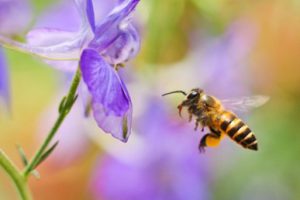 Honey bees cannot fly straight after ingesting pesticides
Honey bees cannot fly straight after ingesting pesticides
Earth.com staff writer
Honey bees fly out of the hive each day in search of flowers with nectar and pollen. Once they have loaded up with these delicacies, they head back to the hive to make a deposit and inform other workers where the successful foraging locations are. All of this relies on a bee’s ability to process wide-field visual motion information, to navigate using environmental queues and to fly directly back home. Research now shows that certain common pesticides interfere with a bee’s brain in such a way that it may no longer be able to navigate its way around or fly home successfully.
“Here we show that commonly used insecticides like sulfoxaflor and the neonicotinoid imidacloprid can profoundly impair the visually guided behavior of honeybees. Our results are reason for concern because the ability of bees to respond appropriately to visual information is crucial for their flight and navigation, and thus their survival,” said study lead author Dr. Rachel H Parkinson, an expert in the Department of Zoology at the University of Oxford.
Insects show an innate orienting behavior whereby they correct their body position in order for them to continue moving in a straight trajectory if they have gone off course by mistake. Known as the optomotor response, this position-stabilizing behavior is switched on by whole-field visual motion on the left and right of the flying or walking insect. The response is crucial for insects to adjust to unexpected perturbations in their flight path, such as a breeze blowing them to one side, so that they can continue to move in a straight line.
Dr. Parkinson and colleagues worked with four groups of wild-caught worker honey bees, with between 22 and 28 bees in each group. They exposed the bees to videos of vertical bars that moved from left to right, or vice versa, across two screens placed in front of the bees and watched their walking response. Variations in the speeds of the bars on the two screens “trick” the bee into thinking that it has suddenly been pushed off-course and is turning to one side. A healthy optomotor response will instruct the bee’s motor system to perform a corrective adjustment in the form of a turn that takes the bee back to an illusory straight line mid-way between the optic flow from the right and from the left.
Prior to testing the optomotor response in the experimental honey bees, the researchers allowed them to drink unlimited 1.5 molar sucrose solution over five days. However, although one group received pure sucrose solution, the other groups received sucrose contaminated with either 50 ppb (parts per billion) imidacloprid (a neonicotinoid insecticide), 50 ppb sulfoxaflor, or 25 ppb imidacloprid and 25 ppb sulfoxaflor simultaneously.
Neonicotinoid insecticides disrupt visual motion detection in locusts, resulting in impaired escape behaviors, but it had not been shown previously whether these insecticides disrupt wide-field motion detection in honeybees. When the researchers compared the efficiency of the optomotor responses in the four groups of bees, they found that the bees were nowhere near as efficient at making the expected adjustments if they had ingested pesticides.
All bees responded less efficiently to the simulated optic flow when the bars were narrow or moving slowly (i.e., seemed far away) than when they were wide or moving fast (i.e., seemed close by). But for any width and speed of bars, the bees that had ingested pesticides performed poorly compared to the control bees. For example, they turned quickly in one direction only and didn’t respond to changes in the direction of movement of the bars, or failed to show any turning response at all. The asymmetry between left and right turns was at least 2.4 times greater for pesticide-exposed bees than for control bees.
The poor optomotor responses in pesticide-exposed honey bees were accompanied by alterations in the expression of genes in their brains, particularly genes related to detoxification and the presence of stress. But these genetic changes were relatively weak and highly variable across bees, and unlikely to be the sole explanation for the observed strong impairment of the optomotor response. Exposure to sulfoxaflor led to small but noticeable increases in dead brain cells, primarily in the optic lobes which are important for processing visual information.
“Neonicotinoid and sulfoximine insecticides activate neurons in the insect brain and are not always recycled fast enough to prevent toxicity. The effects we observed could be due to a type of rewiring in the brain: to prevent neural damage by reducing the sensitivity of neurons to these compounds,” said Dr. Parkinson.
“To fully understand the risk of these insecticides to bees, we need to explore whether the effects we observed in walking bees occur in freely flying bees as well. The major concern is that, if bees are unable to overcome any impairment while flying, there could be profound negative effects on their ability to forage, navigate, and pollinate wildflowers and crops.”
“The results add to what the Food and Agriculture Organization of the United Nations, and the World Health Organization, have identified as the “rapidly growing body of evidence [which] strongly suggests that the existing levels of environmental contamination [from neonicotinoid pesticides] are causing large-scale adverse effects on bees and other beneficial insects.”
The research is published in the journal Frontiers in Insect Science.
We are here to share current happenings in the bee industry. Bee Culture gathers and shares articles published by outside sources. For more information about this specific article, please visit the original publish source: Honey bees cannot fly straight after ingesting pesticides • Earth.com








